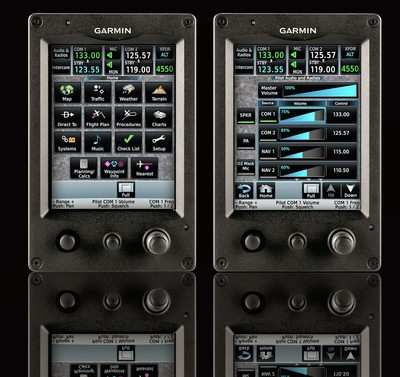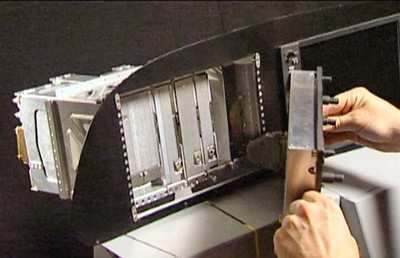See It On
Aero-TV! G3000 Integrated FlightDeck Brings Touchscreen and
Widescreens to the Cockpit
 If you were wondering why ANN's Jim Campbell was so hard to
get a hold of last Monday, this is the reason -- he was in Olathe,
KS, getting an early look at Garmin's aggressively engineered
new glass panel flightdeck for turbine aircraft... the G3000 (and
yes, having a heckuva time!). Garmin's G3000 is the first
touchscreen-controlled integrated flightdeck for light turbine
aircraft. The G3000 is designed specifically for Part 23 turbine
aircraft, and has just been announced at the 2009 NBAA
Convention.
If you were wondering why ANN's Jim Campbell was so hard to
get a hold of last Monday, this is the reason -- he was in Olathe,
KS, getting an early look at Garmin's aggressively engineered
new glass panel flightdeck for turbine aircraft... the G3000 (and
yes, having a heckuva time!). Garmin's G3000 is the first
touchscreen-controlled integrated flightdeck for light turbine
aircraft. The G3000 is designed specifically for Part 23 turbine
aircraft, and has just been announced at the 2009 NBAA
Convention.
"In 2003, we transformed the general aviation cockpit with the
G1000, and now we're taking the next leap forward with the G3000,"
said Gary Kelley, Garmin's vice president of marketing. "The G3000
is a testament to the culture of innovation that is fundamental to
Garmin, and it promises to be one of the most intuitive and
powerful flightdeck systems ever designed for Part 23 turbine
aircraft."

The G3000 seamlessly integrates numerous Garmin-designed system
components into an easy-to-use flightdeck:
Intuitive, Icon-Driven Interface
The G3000 incorporates the all new GTC 570 vehicle management
system, a 5.7-inch diagonal touchscreen controller that uses a
desktop-like menu interface with intuitive icons. The
console-mounted GTC 570 allows for full control for radio
management, audio management, flight management, weather systems
management, and synoptics and other vehicle systems.

The simplistic user interface leverages the experience Garmin
has gained by designing and delivering millions of automotive
consumer products, and it eliminates buttons, switches, and
extraneous knobs. The touchscreen also enhances ease of use through
common sense functions like "back" and "home" that let pilots
quickly retrace their steps or return to the home screen. The GTC
570 vehicle management system uses patent pending, infrared
touchscreen technology, audio and visual feedback, and animation to
help pilots know exactly how the system is responding to their
input.
"We've gone to great lengths to make the G3000 simple to
operate," said Kelley. "For example, with the GTC 570, pilots touch
the information they want to change rather than using cursors. This
intuitive approach makes it easy to enter the information right the
first time, and helps decrease pilot workload."
The GTC 570 also incorporates three conventional knobs at the
bottom of the display: a volume control knob, dedicated map
joystick and dual concentric knob for data entry. Pilots may choose
to use the knobs instead of the touchscreen to enter information
and the knobs' functions are always labeled on the display.
Extra-Wide, Split-Screen Displays
The primary flight displays (PFD) and multi-function display
(MFD) are 14.1-inch diagonal WXGA high resolution wide aspect ratio
displays. The large landscape oriented displays make it possible to
have an enhanced view of Synthetic Vision Technology (SVT) that
displays three dimensional terrain, obstacles, pathways, and
traffic. Situational awareness is enhanced further with a large
inset map, and an extended horizon line.

The G3000's large MFD also has split-screen capability so that
two separate vertical pages may be viewed side-by-side. Pilots may
simultaneously view maps, charts, TAWS, flight planning, weather or
video input pages. In addition, aircraft synoptics can be
graphically depicted on the MFD to help simplify monitoring and
speed troubleshooting.
As with the G1000, the G3000 has full reversionary capabilities,
including in-flight dynamic restarts, so that all flight critical
data can be transferred seamlessly to a single display for added
safety during flight.
The G3000 also includes a fully capable three-axis, fully
digital, dual channel, fail passive auto flight system. The
autopilot includes features you would expect in this class of
aircraft such as coupled wide area augmentation system (WAAS)
approaches, vertical navigation, and flight level change (FLC).
Added Perspective
On the G3000's widescreens, Garmin's synthetic vision technology
(SVT) presents near life-like 3D depictions of terrain, obstacles,
traffic and the runway environment so that the image on the display
replicates what pilots would see outside the cockpit on a clear
day. SVT works seamlessly to alert pilots of potential ground
hazards by displaying terrain and obstacles which pose a threat to
the aircraft with appropriate TAWS alert coloring, as well as voice
alerts. SVT also includes pathways (or Highway-In-The-Sky) that are
depicted as 3D "flying rectangles" and help pilots stay on course
when flying en route legs, VNAV legs, GPS/WAAS vertical approach
procedures, ILS approach procedures, and arrival and departure
procedures.
The G3000 avionics suite also integrates synoptics (graphical
systems displays), Garmin's SafeTaxi®, FliteCharts® and
ChartView (optional), which simplify operation, enhance situational
awareness, and increase safety during flight and when taxiing.
Garmin SafeTaxi includes over 950 U.S. airports and helps pilots
navigate unfamiliar airports while taxiing by identifying runways,
taxiways, runway incursion hotspots, and hangars, as well as the
aircraft's exact location on the field. FliteCharts is an
electronic version of the AeroNav Charts (formerly known as the
NACO U.S. Terminal Procedures Publication) and lets pilots quickly
find and view all Departure Procedures (DP), Standard Terminal
Arrival Routes (STARs), approach charts, and airport diagrams on
the MFD. Garmin ChartView is an electronic version of Jeppesen's
extensive library of charts and airport diagrams displayed directly
on the G3000's MFD.

Garmin expects to receive G3000 Technical Standard Orders (TSO)
certification in the second half of 2011.
 ANN's Daily Aero-Linx (04.15.24)
ANN's Daily Aero-Linx (04.15.24) Classic Aero-TV: 'No Other Options' -- The Israeli Air Force's Danny Shapira
Classic Aero-TV: 'No Other Options' -- The Israeli Air Force's Danny Shapira Aero-News: Quote of the Day (04.15.24)
Aero-News: Quote of the Day (04.15.24) Airborne 04.16.24: RV Update, Affordable Flying Expo, Diamond Lil
Airborne 04.16.24: RV Update, Affordable Flying Expo, Diamond Lil ANN's Daily Aero-Term (04.16.24): Chart Supplement US
ANN's Daily Aero-Term (04.16.24): Chart Supplement US







